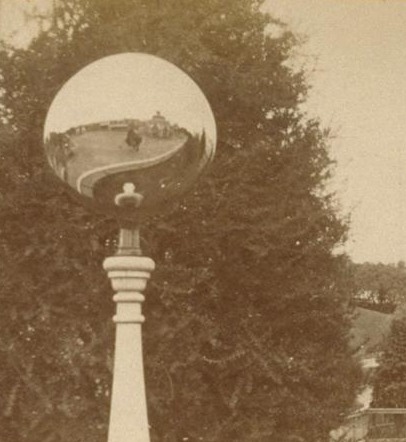I’ve seen a million and one lawn ornaments without ever noticing any connection to satelloons. And then I saw this odd ball self-portrait of Edwaerd Muybridge last spring at the Corcoran [detail below], and I”m like, big shiny Victorian garden balls and satelloons!

Actually, I see it was the other way around: Muybridge was in May, and tricky photographs using mirrored balls that happened to be satellites was in March.

Anyway, that’s when I realize I have no idea what they’re actually called, or how to find them, because they’re called something besides “those+glass+lawn+balls” or whatever. And so I start trying to figure out when I might accidentally run into our neighbor who has one, so I can ask.
Then last fall, on a trip to Amsterdam, we were walking through the antique scientific instrument district, we went into Staetshuys Antiquairs, which had some incredible and odd-looking globes and orreries in the window. And there on the edge of the mezzanine:

Big [and small] shiny balls. Thick-looking, silvered glass globes, but hanging on chains, not sitting on grass. Staetshuys’s Stephan Meulendijks explained that they are called witch balls, and they served to deflect evil spirits from the windows of your house in 18th century England. Most witch balls I see discussed online, though, seem to date from the late 19th and early 20th century.
Wikipedia’s entry for witch balls shows hand-sized globes, but a couple at Staetshuys measured at least 30-40cm. [Actually, the one pictured, from the V&A, which was originally “acquired as a ‘Witches ball,'” and is now labeled a “bauble,” is “almost certainly a Christmas tree decoration.”
Anyway, the garden variety, are known as gazing balls, which is pretty close to a satelloon after all.
Skip to content
the making of, by greg allen
